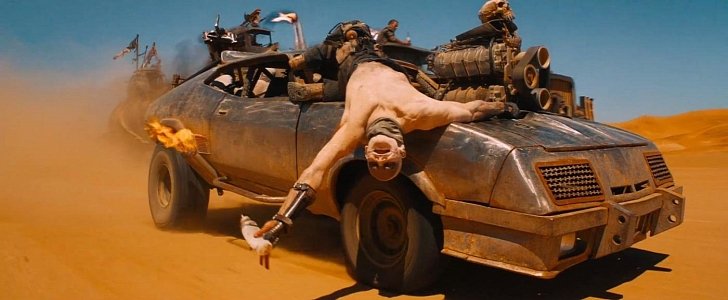Car movies have gained a lot of popularity in recent years, mostly thanks to the Fast & Furious franchise, but no other car movie can match Mad Max: Fury Road in terms of brutality, realism or sheer awesomeness.
It’s been five years since Fury Road, once Warner Bros.’ biggest gamble, dropped in theaters and, to mark this important occasion, the New York Times is running an oral history of the troubled production. And troubled it was, from the time and money needed to build those awesome / terrifying rigs and then have then shipped to Namibia, to the extended shoot that went over budget, the two cancellations, and the feeling of cabin fever all cast and production crew got from ending up stuck together for months on end in the desert.
The story of Mad Max: Fury Road is as fascinating and sometimes brutal as the movie itself. Original Mad Max director George Miller had a dream for the sequel but no studio wanted to sink this much money into it. Miller notoriously insisted on shooting all action scenes in real life, using practical stunts instead of CGI. When you have a car or rig crashing every second in certain scenes, that’s a risk few investors would dare take – let alone a family-friendly studio like Warners.
Miller also had an idea of creating the Wasteland universe and have everyone else actually living in it, to render the shoot more realistic. In the end, it worked out, but cast members often came to blows (especially Tom Hardy and Charlize Theron, or Hardy and Miller himself), crew felt like they were losing all track of reality, and no one knew where the project was going. Because Miller, always an idea-guy, was shooting an entire war movie off of storyboards.
After the crew spent several months stuck on a truck, swallowing dust and enduring all sorts of physical hardships, doing several dangerous stunts on a daily basis, and losing all touch with reality, the film was completed. Looking back, Theron would say fear is what drove the production. Of everything.
“The biggest thing that was driving that entire production was fear,” she says in the NYT piece. “I was incredibly scared, because I’d never done anything like it. I think the hardest thing between me and George is that he had the movie in his head and I was so desperate to understand it.”
The full piece includes quotes from everyone from Miller to Hardy, stuntmen, supporting actors and producers. It’s a longer read but well worth your time if you liked Fury Road and appreciated it for the truly revolutionary piece of moviemaking it was (and still is). And it might just make you revisit it once you’re done.
The story of Mad Max: Fury Road is as fascinating and sometimes brutal as the movie itself. Original Mad Max director George Miller had a dream for the sequel but no studio wanted to sink this much money into it. Miller notoriously insisted on shooting all action scenes in real life, using practical stunts instead of CGI. When you have a car or rig crashing every second in certain scenes, that’s a risk few investors would dare take – let alone a family-friendly studio like Warners.
Miller also had an idea of creating the Wasteland universe and have everyone else actually living in it, to render the shoot more realistic. In the end, it worked out, but cast members often came to blows (especially Tom Hardy and Charlize Theron, or Hardy and Miller himself), crew felt like they were losing all track of reality, and no one knew where the project was going. Because Miller, always an idea-guy, was shooting an entire war movie off of storyboards.
After the crew spent several months stuck on a truck, swallowing dust and enduring all sorts of physical hardships, doing several dangerous stunts on a daily basis, and losing all touch with reality, the film was completed. Looking back, Theron would say fear is what drove the production. Of everything.
“The biggest thing that was driving that entire production was fear,” she says in the NYT piece. “I was incredibly scared, because I’d never done anything like it. I think the hardest thing between me and George is that he had the movie in his head and I was so desperate to understand it.”
The full piece includes quotes from everyone from Miller to Hardy, stuntmen, supporting actors and producers. It’s a longer read but well worth your time if you liked Fury Road and appreciated it for the truly revolutionary piece of moviemaking it was (and still is). And it might just make you revisit it once you’re done.










